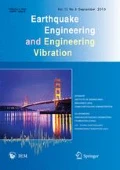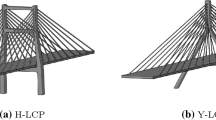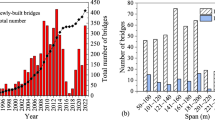Abstract
The spatial variability of input ground motion at supporting foundations plays a key role in the structural response of cable-stayed bridges (CSBs); therefore, spatial variation effects should be included in the analysis and design of effective vibration control systems. The control of CSBs represents a challenging and unique problem, with many complexities in modeling, control design and implementation, since the control system should be designed not only to mitigate the dynamic component of the structural response but also to counteract the effects of the pseudo-static component of the response. The spatial variability effects on the feasibility and efficiency of seismic control systems for the vibration control of CSBs are investigated in this paper. The assumption of uniform earthquake motion along the entire bridge may result in quantitative and qualitative differences in seismic response as compared with those produced by uniform motion at all supports. A systematic comparison of passive and active system performance in reducing the structural responses is performed, focusing on the effect of the spatially varying earthquake ground motion on the seismic response of a benchmark CSB model with different control strategies, and demonstrates the importance of accounting for the spatial variability of excitations.
Similar content being viewed by others
References
Abdel Raheem SE and Dorka UE (2006), “Feasibility Study on Semi-active Control of the Cable-stayed Bridge Benchmark with Friction Device System,” 4th World Conference on Structural Control and Monitoring, 4WCSCM, 11–13 July 2006, San Diego, California, Paper No. 32.
Abdel Raheem SE, Dorka UE and Hayashikawa T (2007), “Friction Based Semi-active Control of Cable-stayed Bridges,” JSCE Journal of Structural Engineering, 53A: 428–438.
Abdel Raheem SE and Hayashikawa T (2003), “Parametric Study on Steel Tower Seismic Response of Cable-stayed Bridges Under Great Earthquake Ground Motion,” JSCE Structural Engineering/Earthquake Engineering, 20(1): 25–41.
Abdel Raheem SE and Hayashikawa T (2007), “Seismic Protection of Cable-stayed Bridges Under Multiple-Support Excitations,” 4th International Earthquake geotechnical Engineering, Thessaloniki, Greece, 25–28 June 2007, Paper No. 1361.
Abdel Raheem SE, Hayashikawa T and Dorka U (2008), “Spatial Variation Effects on Seismic Response Control of Cable-stayed Bridges,” 14th World Conference on Earthquake Engineering, Beijing, China, 12–17 October 2008, Paper No. 05-02-0015.
Ali HM and Abdel-Ghaffar AM (1995a), “Modeling the Nonlinear Seismic Behavior of Cable-stayed Bridges with Passive Control Bearings,” Computers & Structures, 54(3): 461–492.
Ali HM and Abdel-Ghaffar AM (1995b), “Seismic Passive Control of Cable-stayed Bridges,” Shock and Vibration, 2(4): 259–272.
Caicedo JM, Dyke SJ, Moon SJ, Bergman LA, Turan G and Hague S (2003), “Phase II Benchmark Control Problem for Seismic Response of Cable-stayed Bridges,” Journal of Structural Control, 10: 137–168.
Dorka UE, Flygare E and Ji A (1998), “Passive Seismic Control of Bridges by Hysteretic Device System,” 2nd World Conference on Structural Control, Kyoto, Japan, June 27–July 1, 1998: 1687–1694.
Dyke SJ, Spencer JR, Sain MK and Carlson JD (1996), “Modeling and Control of Magnetorheological Dampers for Seismic Response Reduction,” Smart Materials and Structures, 5: 565–575.
Dyke SJ, Turan G., Caicedo JM, Bergman LA and Hague S (2000), “Benchmark Control Problem for Seismic Response of Cable-stayed Bridges,” http://wusceel.civewustl.edu/quake.
Fujino Y (2002), “Vibration, Control and Monitoring of Long-span Bridges-recent Research, Developments and Practice in Japan,” Journal of Constructional Steel Research, 58: 71–97.
Ganev T, Yamazaki F, Ishizaki H and Kitazawa M (1998), “Response Analysis of the Higashi Kobe Bridge and Surrounding Soil in the 1995 Hyogoken Nanbu Earthquake,” Earthquake Engineering and Structural Dynamics, 27: 557–576.
Harichandran RS, Hawwari A and Sweidan BN (1996), “Response of Long-span Bridges to Spatially Varying Ground Motion,” Journal of Structural Engineering, 122: 476–484.
Iemura H and Pradono MH (2002), “Passive and Semiactive Seismic Response Control of a Cable-stayed Bridge,” Journal of Structural Control, 9: 189–204.
Jansen LM and Dyke SJ (2002), “Semi-active Control Strategies for MR Dampers: Comparative Study,” Journal of Engineering Mechanics, 126(8): 795–803.
Lin JH and Zhang YH (2005), Vibration and Shock Handbook, Chapter 30: “Seismic Random Vibration of Long-span Structures,” CRC Press, Taylor & Francis: Boca Raton, FL 2005.
Lin JH, Zhang YH, Li QS and Williams FW (2004), “Seismic Spatial Effects for Long-span Bridges, Using the Pseudo Excitation Method,” Engineering Structures, 26: 1207–1216.
Robinson WH (1982), “Lead-rubber Hysteretic Bearings Suitable for Protecting Structures During Earthquakes,” Earthquake Engineering and Structural Dynamics, 10: 593–604.
Saxena V, Deodatis G and Shinozuka M (2000), “Effect of Spatial Variation of Earthquake Ground Motion on the Nonlinear Dynamic Response of Highway Bridges,” 12th World Conference on Earthquake Engineering, Kyoto-Japan, Paper No. 2227.
Soong TT, Active Structural Control, Theory and Practice, Longman: UK, 1990.
Soyluk K and Dumanoglu AA (2004), “Spatial Variability Effects of Ground Motions on Cable-stayed Bridges,” Soil Dynamics and Earthquake Engineering, 24: 241–250.
Soyluk K, Domanoglu AA and Tuna ME (2004), “Random Vibration and Deterministic Analysis of Cable-stayed Bridges to Asynchronous Ground Motion,” Structural Engineering and Mechanics, 18(2).
Zerva A (1991), “Effect of Spatial Variability and Propagation of Seismic Ground Motions on the Response of Multiply Supported Structures,” Probability Engineering Mechanics, 6: 212–221.
Author information
Authors and Affiliations
Corresponding author
Additional information
Supported by: Alexander von Humboldt Fellowship-AvH (IV-AGY/1117497 STP) and Japan Society for the Promotion of Science-JSPS Fellowship (P06138)
Rights and permissions
About this article
Cite this article
Abdel Raheem, S.E., Hayashikawa, T. & Dorka, U. Ground motion spatial variability effects on seismic response control of cable-stayed bridges. Earthq. Eng. Eng. Vib. 10, 37–49 (2011). https://doi.org/10.1007/s11803-011-0045-5
Received:
Accepted:
Published:
Issue Date:
DOI: https://doi.org/10.1007/s11803-011-0045-5




